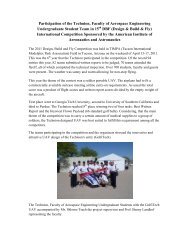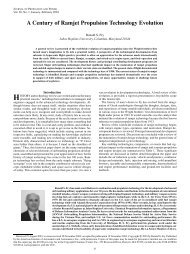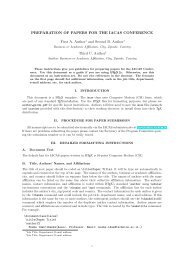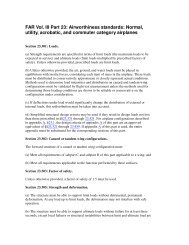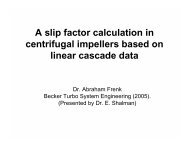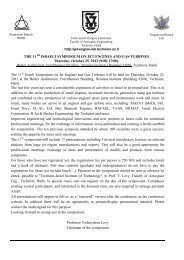Cargo Airships Prospective - Faculty of Aerospace Engineering
Cargo Airships Prospective - Faculty of Aerospace Engineering
Cargo Airships Prospective - Faculty of Aerospace Engineering
Create successful ePaper yourself
Turn your PDF publications into a flip-book with our unique Google optimized e-Paper software.
significant structure weight reduction, but on the same time, does not allow high loads;<br />
literally only slow cruise speed and small payload is allowed. Thus blimps are usually the<br />
smallest in the variety <strong>of</strong> airships, and used mainly for purposes <strong>of</strong> local surveillance, airborne<br />
advertising and as a small tour vehicle. Fully rigid airships, as were the giant zeppelins <strong>of</strong> the<br />
past, are at the opposite side <strong>of</strong> scale. They have full internal framework that is not only<br />
intended for the loads but for keeping the external form as well. This makes ballonet system<br />
unnecessary to some point, but on the other hand, increases vastly the structure weight, on the<br />
expense <strong>of</strong> the potential useful load. Semi-rigid airships are basically a trade-<strong>of</strong>f option<br />
between the two. It is similar to non-rigid ones, with the difference <strong>of</strong> owing some sort <strong>of</strong><br />
load-bearing internal structure; by this achieving higher load tenability, with reasonable<br />
penalty <strong>of</strong> the additional weight. Progress in the field <strong>of</strong> the building materials, as will be<br />
presented in the next paragraph, has allowed building stronger and tougher semi-rigid<br />
airships, thus making them a preferred option. While not utterly disbanded, rigid airship<br />
designs are rare nowadays and most <strong>of</strong> the current designs are based on semi-rigid hulls for<br />
cargo airships and non-rigid for lighter applications.<br />
Figure 6. Three examples <strong>of</strong> main airship structure types presented. From left to right: Goodyear nonrigid<br />
blimp, Zeppelin NT semi-rigid airship and USS Shenandoah rigid zeppelin.<br />
IV. Technologies<br />
History <strong>of</strong> flight is fully bound with the technological progress. New technology<br />
development, has allowed incremental improvement <strong>of</strong> the flight vehicles, beyond the<br />
previously known frontiers. Same principle is relevant for all types <strong>of</strong> aircraft and for lighterthan-air<br />
vehicles as well. The evolution <strong>of</strong> advanced designs and its competitive advantages<br />
(compared to the past), took place mostly because <strong>of</strong> technological progress in materials,<br />
avionics, systems and propulsion.<br />
With no doubt, one <strong>of</strong> the greatest progress advances in airship technology was made in<br />
the areas <strong>of</strong> structure and materials. Massive metal internal structure was substituted by<br />
lightweight and strong composite framework. Implementing aircraft based experience on<br />
composites, lead to building much lighter gondola, engine nacelles and systems casing.<br />
Polymer based, multi-layered, impervious and durable envelope material took place <strong>of</strong> former<br />
heavier and more permeable fabrics <strong>of</strong> the airship's envelope. Zeppelin's skin was usually<br />
made from heavy cotton fabric, which was soaked with rubberized coating and externally<br />
laminated with aluminum coating for better weathering durability. The lifting gas was stored<br />
inside it, in separate gas cells, made from intestines <strong>of</strong> cattle and goats. Contemporary<br />
airship's skin is usually made <strong>of</strong> at least three layers – load bearing layer made <strong>of</strong> tough<br />
material (like Kevlar or Vectran), non-permeable layer made <strong>of</strong> Mylar and additional polymer<br />
coating (like Tedlar), for increased imperviability and weathering resistance. The results <strong>of</strong><br />
improving envelope materials are; lesser weight, better lifting gas sealing and higher<br />
structural strength. Constantly improving synthetic and fiber materials development and








